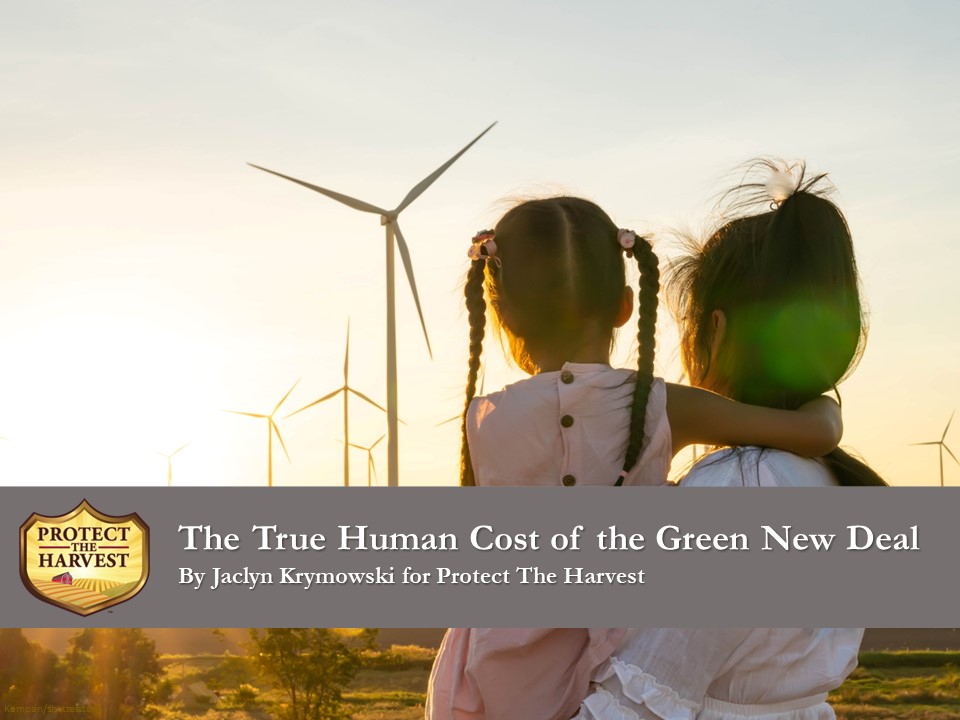
By Jaclyn Krymowski for Protect The Harvest
Sustainability continues to be a topic of global interest taking a front-row seat on the agenda of Non-Governmental Organizations (NGOs), governments, companies, consumers, and everything in between.
One of the most well-known examples of this is the Green New Deal introduced by Representative Alexandria Ocasio-Cortez and Senator Edward Markey lays out a set of very broad environmental, sustainability, and climate change-based goals. This resolution hopes to see a world with net zero emissions by 2050 or even sooner. This sounds like a great idea however; a deeper look reveals that it sets that goal with no restrictions as to the impact on society and life as we know it.
While seemingly well-intentioned, many initiatives and proposals that are pushed forward to meet the deal’s ideals come with a hefty cost for the people involved. Nowhere is this more apparent than when politics come into play and the enforcement of policies ends up placing “sustainability” far above human needs. Essentially, these forces are trying to achieve arbitrarily established goals in ways that are often impractical and even dangerous.
Advancements in technology have helped enhance efficiency and environmental preservation in certain circumstances. What has not been made public is that some of these solutions are not necessarily the “end-all-be-all” that certain special interests and politicians have propped them up to be. Even the best technologies come with limitations and the discussion between renewable resources versus fossil fuels isn’t as cut and dry as it may seem.
What is the Green New Deal Really About?
The Green New Deal has become a tug-of-war between lawmakers. The publicized objective of the Green New Deal is to reduce greenhouse gasses to limit the impact of climate change. However, most people are not aware that the Green New Deal agenda is part of other, similar campaigns all aimed at the same goal: control. The other campaigns include the Great Reset, America the Beautiful (30 by 30), 50 x 40 (which aims to reduce animal agriculture 50% by 2040), Wildlife Corridors by Conservation Act, National Heritage Areas, and more. In a nutshell, the Green New Deal extends into tackling other issues that are being promoted as being the root of a changing climate. This includes looping together poverty, income inequality, and racial and environmental discrimination.
The New York Times lays out the agenda of the Green New Deal:
“The Green New Deal calls on the federal government to dramatically reduce greenhouse gas emissions, create high-paying jobs, ensure that clean air, clean water, and healthy food are basic human rights, and end all forms of oppression.”
But a look beneath the surface shows a lot of serious issues with meeting these goals by embracing new practices and alternative solutions for fuel, energy, and even food production that don’t take into consideration the people who are impacted.
Green and Clean Energy Can’t Meet Demand
We continue to see the issues with changing to the strict use of categorized “green energy.” Previous power grid failures, weather conditions, and more have proven that proposed “green” solutions for “clean” energy are simply not up to the task to meet demand. In Texas, a petition was submitted to temporarily waive regulator quotas in preparation for bad winter weather. Justifications were made by the Depart of Energy listing the reason that additional generation could result in a conflict with environmental standards. Not to mention, there are times of the year when wind and solar production are naturally limited availability.
The Realities Across the Globe
The failure of green energy to meet demand is not unique to the United States. The crushing costs and lack of sufficient output of alternative resources have been felt by countries around the world. European nations have transitioned from Russia as their primary fuel provider. Germany has struggled in their efforts to replace traditional energy resources with green sources.
“They spent $150 billion on renewable energy sources in their own version of the Green New Deal, only to find itself with some of the highest energy prices in the world and wind power production plummeting,” reads an opinion piece in The Hill.
The reality is that the United States has been the one to fill in the gap in Europe’s demand for reliable energy. The international publication LeMonde reported the following in an article:
“Despite climate commitments, the EU is going back to coal. Faced with gas shortages, several EU member states, including France, have announced the extension or reopening of coal-fired power plants that were shut down in response to climate change issues.”
“At the end of June (2022), Chancellor Olaf Scholz’s coalition gave the green light to restart 27 coal-fired power plants until March 2024. The German government is not the only one to make this decision, even though it is at odds with the fight against greenhouse gases. Within the European Union (EU), some countries – Austria, Italy, the Netherlands, and France – have announced their intent to extend or restart power plants that were shut down, in an attempt to get through the next few months safely.”
Hard Lessons Should Be Learned from Failed Green Policies
Europe’s fruitless energy policies and energy crisis are a case study and serious wake-up call for the United States about the blunt realities of moving towards a fully or near fully “alternative” energy grid. Besides lack of reliability, many alternative energy sources also come with very high upfront and maintenance costs and are restricted to certain land types and availability. This often sets up land-use competition between food production and energy. Living conditions and quality of human life rely heavily on available and affordable energy. In the United Kingdom, households are dealing with energy bills so high they are unaffordable.
A good example here in the United States is California where rolling blackouts, brownouts, and requests to refrain from charging electric cars have become commonplace. California generates more electricity from non-hydroelectric renewable energy resources than any other state in the country. Half the electricity in the state is produced from natural gas plants meanwhile California lawmakers seem to be in full attack mode against the use of natural gas. Additionally, due to its large population, California has the second-highest total energy demand in the country and thus imports electricity from other states.
California Congressman Tom McClintock has been vocal about the true sustainability issues surrounding the Green New Deal. In an address to congress, he stated, “These Green New Deal policies can’t guarantee enough electricity to keep the lights on this summer – at any price – these Democrat elitists are telling families to buy electric cars. Where do they think the electricity for their electric cars comes from? Eighty percent comes from fossil fuels – that they are ruthlessly shutting down,” he says. McClintock has also noted that gasoline and electricity prices have climbed though the production of gasoline has decreased. “Electricity prices are skyrocketing, pushed by the crushing cost of renewables,” he says. “Utilities across the country are now warning of summer blackouts because renewable mandates have destabilized the electricity grid.”
Green New Deal Threatens Food Security
The high costs of so-called “sustainable” energy directly impact our food supply chain. Rep. McClintock mentions the land once used for food is now being used to create green resources such as ethanol.
Farmers continue to struggle with the high cost of diesel fuel and the associated costs of transportation of commodities like livestock feed, seed, and fertilizer among other inputs.
These not only strain farm and ranch families who already struggle to remain profitable, but it also dramatically raises the prices at the retail end. This not only impacts families that are already food insecure, but it threatens to put more families into that category by limiting access to nutrient-dense foods.
Beware the High Cost of Being “Green”
Pushing for green or renewable sources creates a long-lasting ripple effect throughout society.
Ironically, as more money, time and research are poured into alternative energy sources, we continue to see more issues arise from their usage. Instead of the government and policymakers taking the brunt of the consequences, it ends up being everyday citizens who suffer from rising costs and a lack of affordable energy to run their homes and businesses.
Policies like the Green New Deal are especially dangerous because they seek to replace traditional, reliable, sustainable energy sources that have been in place for decades. Diving into the lofty goals of these policies full force threatens to disrupt society in dangerous ways without a failsafe.
This could easily overwhelm our power grid or fail to supply adequate energy altogether which will undoubtedly cause more economic strain than if traditional resources were used.
Proponents of the Green New Deal could stand to learn much from other countries, specifically in Europe. Understanding their energy-related dilemmas shows us the need to carefully balance alternative energies with the traditional.
Links
McClintock Speech HERE
New York Times article HERE
Newsweek article HERE
The New American article HERE
National Geographic article HERE
Washington Times article HERE
Bold Business article HERE
The Hill article HERE
NBC News article HERE
Article about EU going back to coal HERE



